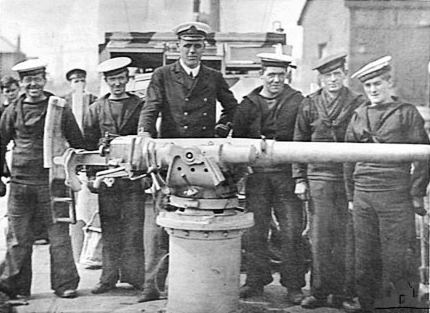Designed 1885 | In service 1886 - 1950s | |
 | ||
Type Naval gunCoast-defence gun Used by French NavyRoyal NavyRegia MarinaUnited States NavyImperial Russian Navy Wars World War IWorld War II | ||
The QF 3-pounder Hotchkiss or in French use Canon Hotchkiss à tir rapide de 47 mm (47mm / L40) was a light 47-mm naval gun introduced in 1886 to defend against new small fast vessels such as torpedo boats, and later submarines. It was also used ashore as a coast defense gun and later occasionally as an anti-aircraft gun.
Contents
United Kingdom History
In 1886 this gun was the first of the modern QF artillery to be adopted by the Royal Navy as the "Ordnance QF 3 pounder Hotchkiss", built under licence by Elswick Ordnance Company.
By the middle of World War I the Hotchkiss gun had become obsolescent, and was gradually replaced in its class by the more powerful Ordnance QF 3 pounder Vickers gun. Of the 2,950 produced it is estimated that 1,948 were still available in 1939 for RN use. The gun's availability, simplicity and light weight resulted in its continued use in small vessels, and many were later brought back into service on merchant vessels used for auxiliary duties in World War II, or as sub-calibre guns for gunnery practice until the 1950s. Early in WWII it was also pressed into service in ports around the British Empire, to defend against possible incursions by motor torpedo boats until the modern QF 6 pounder 10 cwt gun became available in numbers for that purpose.
Australian service
A 3-pounder Hotchkiss was used on an improvised mounting in a battle that resulted in Australia's first prisoners of World War 2 being captured in 1940 near Berbera.
The guns are now used in a Three Pound Saluting Gun Battery at the Garden Island Naval Base.
Russian service
Russia adopted the Hotchkiss 5-barrel Gatling-type 3-pounder revolver cannon in the 1880s, and later adopted the less complicated single-barrel quick-firing weapon. The 5-barrel guns were equipped on the Ekaterina II-class battleships commissioned in 1889, but by 1892 the battleship Dvenadsat Apostolov and her successors had single-barrel weapons. 47 mm Hotchkiss guns were used during the Russo-Japanese war and were ineffective against Japanese torpedo boats, so they were removed from first-line warships following that war. New Russian battleships ceased carrying the weapon with the Evstafi class, commissioned in 1910. However, they were subsequently fitted to patrol vessels and river craft during World War I, and at least 62 weapons were converted to anti-aircraft guns by 1917.
US service
The US Navy used several types of 3-pounder guns, and it is difficult to determine from references which type a particular ship had. Hotchkiss 5-barrel Gatling-type 3-pounder revolving cannon were used, along with single-barrel quick-firing single-shot Hotchkiss 3-pounders. Both are called rapid-firing (RF) in references. Other manufacturers included Driggs-Schroeder, Maxim-Nordenfelt, and Vickers-Maxim. By 1910 the US was building the dreadnought-type South Carolina class, with a secondary armament composed entirely of 3 inch (76 mm) guns. Although removed from first-line warships by World War I, some 3-pounders were fitted on patrol vessels of that war, with a few weapons serving on those ships through World War II.
Polish service
47 mm Hotchkiss guns, designated as wz.1885 gun, were used on first ships of the Polish Navy, received after World War I, like ex-German torpedo boats and minesweepers. By the time of World War II they were mostly phased out of service on naval ships, but several stored guns were used in combat on improvised stationary mounts by Land Coastal Defence units in the Battle of Kępa Oksywska in September 1939.
Surviving examples
3 Guns used for ceremonial purposes at HMS Drake.
